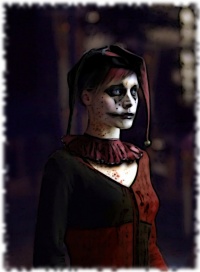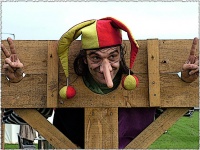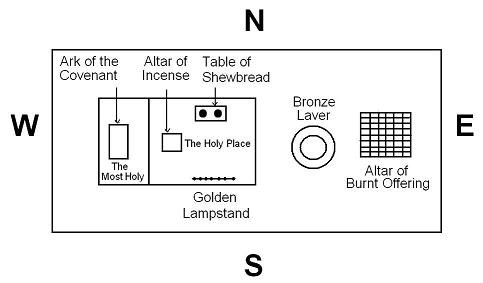Shanty of Fools: Difference between revisions
No edit summary |
No edit summary |
||
| Line 1: | Line 1: | ||
;[[St.Calenda's Wandering Pageant, Odeum & Lunar Fair]] | ;[[St.Calenda's Wandering Pageant, Odeum & Lunar Fair]] | ||
== Introductions == | == Introductions == | ||
''''Description: ''' The lodgings and performance venue of the pageant's collective of fools, the shanty is a ramshackle structure formed of spare sackcloth, rope, odds and ends and fallen logs. While distinctly unimpressive as seen from without, once inside the ''Shanty'' visitors and pageant-folk who are not fools themselves become lost in a maze of clothbound corridors whose dimensions far exceed ''normal'' expectations. But the Shanty is not a maze, so much as a labyrinth which leads the brave ever deeper towards a central chamber called the ''"Tabernacle"''. All along the corridors of the shanty-labyrinth are recesses in which ''scenes'' are played out for the paying visitors and for those who trespass within the private sanctum of the fools. These scenes are ''supposed'' to serve as a series of morality plays meant to remind the visitor-folk of their ethical and spiritual obligations and what ''might'' await them after death should they they fail to keep faith. But, all-too-often, these ''performances'' do the opposite, revealing the ''holes'' in medieval life and presenting the visitor with a distinct emotional or moral dilemma which they must solve if they wish to escape the Shanty by reaching the central ''"Tabernacle of Fools"''. All too often, however, visitors who enter are never seen again and it is assumed by those within their communities that they simply ran away with the pageant. | ''''Description: ''' The lodgings and performance venue of the pageant's collective of fools, the shanty is a ramshackle structure formed of spare sackcloth, rope, odds and ends and fallen logs. While distinctly unimpressive as seen from without, once inside the ''Shanty'' visitors and pageant-folk who are not fools themselves become lost in a maze of clothbound corridors ending in doors whose dimensions far exceed ''normal'' expectations. But the Shanty is not a maze, so much as a labyrinth which leads the brave ever deeper towards a central chamber called the ''"Tabernacle"''. All along the corridors of the shanty-labyrinth are recesses in which ''scenes'' are played out for the paying visitors and for those who trespass within the private sanctum of the fools. These scenes are ''supposed'' to serve as a series of morality plays meant to remind the visitor-folk of their ethical and spiritual obligations and what ''might'' await them after death should they they fail to keep faith. But, all-too-often, these ''performances'' do the opposite, revealing the ''holes'' in medieval life and presenting the visitor with a distinct emotional or moral dilemma which they must solve if they wish to escape the Shanty by reaching the central ''"Tabernacle of Fools"''. All too often, however, visitors who enter are never seen again and it is assumed by those within their communities that they simply ran away with the pageant. | ||
'''Background: ''' | '''Background: '''Carna, Lady of Doorways, guardian of the passage from one place to another, one world to another, was originally worshiped by the men in white face, the Praefators of Cranae. The worship of the lady was established around the pulling of a wagon, drawn by two white oxen around the countryside blessing the homes of families, driving away evil spirits. Nobody was allowed to see the White Lady, looking apon her brought bad luck, but she could bless a house and bring prosperity for years. Things changed, and the world darkened. The childer of Kayen came and hunted the families Cranae was supposed to protect, and her priesthood became harried. There were many things in the dark, and the Praefators couldn't be everywhere. Followers had doubt, and in time the Festival of Cranae became less than it was, making the work of her followers much harder. | ||
In the dark of night came a beast, a monster that lived on the ravaging of men and women, on the harvesting of the Sons of Seth. The High Priest drove her away, but she returned again and again begging for shelter. Cranae invited her in and fed her from her lofty veins, giving that creature power undreamed of. But this blood also brought the knowledge that the children of Kayen were hunting and killing the sons of Seth. Over many nights the two talked, learning from each other. The elder creature Namrael the Enochite was swayed by the kindness and concern of Cranae, agreeing to give her power and blood to make sure that the Festivals of Cranae never died out. In the end her sacrifice on the ''Kalendae'' sealed the power that became the basis for the Pageant. | |||
The white faced Praefators bowed in awe, and renewed their struggle to keep the doors that should open Open, and those that should close slam with finality. Down their the ages members came to find their vitality boosted as they traveled with the Pageant. Cranae over time and with reverence became Carna, and she truly slipped into the dark invisible night, becoming completely the opener of gateways, helping the righteous slip peacefully into Oblivion, and the evil to be trapped here. The darkness increased, and with the launching of the Order of Reason began the closing of Carna's power. Artisans crafted away the symbolic knots and twists on doors that represented Carna, and the Goddess weakened, even as the blood of Namrael kept the Pageant going. | |||
Honorina Regin was the Procuress of the Pageant, leading them down darkened roads of Siberia, using the power of Carna to move the Pageant. Outside of Qatna Honorina fought a group of sorcerers, who began using the power of Carna against her followers, twisting the weft of fate to bring the Pageant the it's festivities to an end. In the end the Praefator Callistus Friduric made a deal with Apophis for his aid, and the Pageant changed forever. Carna became the gatekeeper to his hellish and sieve of souls. Periodically Carna was forced to open the gate between worlds so Apophis could feed more readily that before. Callistus took up the mantle of Lord of Rains. | |||
Almost a century later Mauritanis chopped the head of Callistus from his body, taking the position of Lord of Rains. In time he morphed it into that of Ringmaster. | |||
'''Contents: ''' | '''Contents: ''' | ||
Revision as of 23:18, 21 December 2018
Introductions
'Description: The lodgings and performance venue of the pageant's collective of fools, the shanty is a ramshackle structure formed of spare sackcloth, rope, odds and ends and fallen logs. While distinctly unimpressive as seen from without, once inside the Shanty visitors and pageant-folk who are not fools themselves become lost in a maze of clothbound corridors ending in doors whose dimensions far exceed normal expectations. But the Shanty is not a maze, so much as a labyrinth which leads the brave ever deeper towards a central chamber called the "Tabernacle". All along the corridors of the shanty-labyrinth are recesses in which scenes are played out for the paying visitors and for those who trespass within the private sanctum of the fools. These scenes are supposed to serve as a series of morality plays meant to remind the visitor-folk of their ethical and spiritual obligations and what might await them after death should they they fail to keep faith. But, all-too-often, these performances do the opposite, revealing the holes in medieval life and presenting the visitor with a distinct emotional or moral dilemma which they must solve if they wish to escape the Shanty by reaching the central "Tabernacle of Fools". All too often, however, visitors who enter are never seen again and it is assumed by those within their communities that they simply ran away with the pageant.
Background: Carna, Lady of Doorways, guardian of the passage from one place to another, one world to another, was originally worshiped by the men in white face, the Praefators of Cranae. The worship of the lady was established around the pulling of a wagon, drawn by two white oxen around the countryside blessing the homes of families, driving away evil spirits. Nobody was allowed to see the White Lady, looking apon her brought bad luck, but she could bless a house and bring prosperity for years. Things changed, and the world darkened. The childer of Kayen came and hunted the families Cranae was supposed to protect, and her priesthood became harried. There were many things in the dark, and the Praefators couldn't be everywhere. Followers had doubt, and in time the Festival of Cranae became less than it was, making the work of her followers much harder.
In the dark of night came a beast, a monster that lived on the ravaging of men and women, on the harvesting of the Sons of Seth. The High Priest drove her away, but she returned again and again begging for shelter. Cranae invited her in and fed her from her lofty veins, giving that creature power undreamed of. But this blood also brought the knowledge that the children of Kayen were hunting and killing the sons of Seth. Over many nights the two talked, learning from each other. The elder creature Namrael the Enochite was swayed by the kindness and concern of Cranae, agreeing to give her power and blood to make sure that the Festivals of Cranae never died out. In the end her sacrifice on the Kalendae sealed the power that became the basis for the Pageant.
The white faced Praefators bowed in awe, and renewed their struggle to keep the doors that should open Open, and those that should close slam with finality. Down their the ages members came to find their vitality boosted as they traveled with the Pageant. Cranae over time and with reverence became Carna, and she truly slipped into the dark invisible night, becoming completely the opener of gateways, helping the righteous slip peacefully into Oblivion, and the evil to be trapped here. The darkness increased, and with the launching of the Order of Reason began the closing of Carna's power. Artisans crafted away the symbolic knots and twists on doors that represented Carna, and the Goddess weakened, even as the blood of Namrael kept the Pageant going.
Honorina Regin was the Procuress of the Pageant, leading them down darkened roads of Siberia, using the power of Carna to move the Pageant. Outside of Qatna Honorina fought a group of sorcerers, who began using the power of Carna against her followers, twisting the weft of fate to bring the Pageant the it's festivities to an end. In the end the Praefator Callistus Friduric made a deal with Apophis for his aid, and the Pageant changed forever. Carna became the gatekeeper to his hellish and sieve of souls. Periodically Carna was forced to open the gate between worlds so Apophis could feed more readily that before. Callistus took up the mantle of Lord of Rains.
Almost a century later Mauritanis chopped the head of Callistus from his body, taking the position of Lord of Rains. In time he morphed it into that of Ringmaster.
Contents:
Tabernacle of Fools
Fools
 Nabil ibn Saqr -- The King Fool {Persian} Nabil ibn Saqr -- The King Fool {Persian}
|
 Wan Lady -- ' {Missing since October of 1094} Wan Lady -- ' {Missing since October of 1094}
|
 Hellequin -- ' {} Hellequin -- ' {}
|
 Bozho -- ' {} Bozho -- ' {}
|
Quote: "Three mages, a Cappadocian vampire and a whole slough of sad clowns." -- Rambert the Oneriomancer
